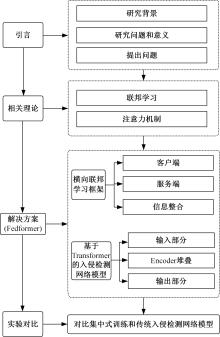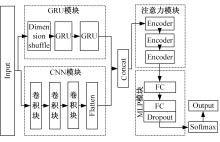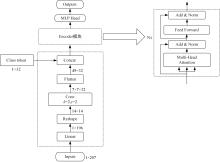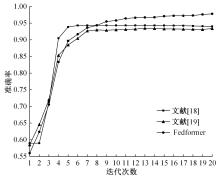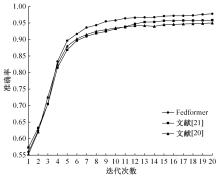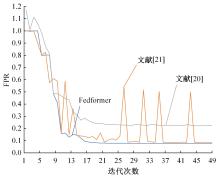Journal of Jilin University(Engineering and Technology Edition) ›› 2023, Vol. 53 ›› Issue (11): 3229-3237.doi: 10.13229/j.cnki.jdxbgxb.20221027
Previous Articles Next Articles
Intrusion detection for industrial internet of things based on federated learning and self-attention
Jun WANG( ),Hua-lin WANG,Bo-wen HUANG,Qiang FU,Jun LIU(
),Hua-lin WANG,Bo-wen HUANG,Qiang FU,Jun LIU( )
)
- College of Computer Science and Technology,Shenyang University of Chemical Technology,Shenyang 110142,China
CLC Number:
- TP399
| 1 | Wang S, Jiang X, Wu Y, et al. Expectation propagation logistic regression(EXPLORER): distributed privacy-preserving online model learning[J]. Biomed Inform, 2013, 46(3):480-496. |
| 2 | Gao D S, Liu Y, Huang A B, et al. Privacy-preserving heterogeneous federated transfer learning[C]∥IEEE International Conference on Big Data, Los Angeles, USA, 2019: 2552-2559. |
| 3 | IEEE Std 3652 1—2020. IEEE Guide for Architectural Framework and Application of Federated Machine Learning [S]. |
| 4 | Mnih V, Heess N, Graves A, et al. Recurrent models of visual attention[J]. Advances in Neural Information Processing Systems, 2014, 3: 1-12. |
| 5 | Bahdanau D, Cho K, Bengio Y. Neural machine translation by jointly learning to align and translate[J]. CoRR, 2014, 1: arXiv.1409.0473. |
| 6 | Vaswani A, Shazeer N, Parmar N, et al. Attention is all you need[J]. NIPS, 2017, 1: arXiv.1706.03762. |
| 7 | Liu Y, Pi D. A novel kernel SVM algorithm with game theory for network intrusion detection[J]. TIIS, 2017, 11(8): 4043-4060. |
| 8 | 燕昺昊, 韩国栋.基于深度循环神经网络和改进SMOTE算法的组合式入侵检测模型[J]. 网络与信息安全学报, 2018, 4(7): 48-59. |
| Yan Bing-hao, Han Guo-dong. Combined intrusion detection model based on deep recurrent neural network and improved SMOTE algorithm[J]. Journal of Network and Information Security, 2018, 4(7): 48-59. | |
| 9 | Wu K H, Chen Z G, Li W. A novel intrusion detection model for a massive network using convolutional neural networks[J]. IEEE Access, 2018(6): 50850-50859. |
| 10 | 李贝贝, 宋佳芮, 杜卿芸, 等. DRL-IDS:基于深度强化学习的工业物联网入侵检测系统[J]. 计算机科学, 2021, 48(7): 47-54. |
| Li Bei-bei, Song Jia-rui, Du Qing-yun, et al. DRL-IDS: intrusion detection system for industrial internet of things based on deep reinforcement learning[J]. Computer Science, 2021, 48(7): 47-54. | |
| 11 | 石乐义, 侯会文, 徐兴华, 等. 基于特征选择和时间卷积网络的工业控制系统入侵检测研究[J]. 工程科学与技术, 2022, 54(6): 238-247. |
| Shi Le-yi, Hou Hui-wen, Xu Xing-hua, et al. Intrusion detection of industrial control systems based on feature selection and temporal convolution network[J]. Engineering Science and Technology, 2022, 54(6): 238-247. | |
| 12 | Nguyen T D, Marchal S, Miettinen M, et al. DïoT: a federated self-learning anomaly detection system for IoT[C]∥IEEE 39th International Conference on Distributed Computing Systems, Dallas, USA, 2019: 756-767. |
| 13 | Liu Y, Kumar N, Xiong Z H, et al. Communication-efficient federated learning for anomaly detection in industrial internet of things[C]∥Proceedings of 2020 IEEE Global Communication Conference, Piscataway, 2020: 1-6. |
| 14 | Wang X D, Garg S, Lin H, et al. Towards accurate anomaly detection in industrial internet-of-things using hierarchical federated learning[J]. IEEE Internet of Things Journal, 2022, 9(10): 7110-7119. |
| 15 | Moustafa N, Slay J. UNSW-NB15: a comprehensive data set for network intrusion detection systems (UNSW-NB15 network data set)[C]∥Military Communications and Information Systems Conference, Canberra, Australia, 2015: 1-6. |
| 16 | Morris T, Gao W. Industrial control system traffic data sets for intrusion detection research[C]∥International Conference on Critical Infrastructure Protection, Arlington, USA, 2014: 65-78. |
| 17 | Yang Q, Liu Y, Chen T, et al. Federated machine learning: concept and applications[J]. ACM Transactions on Intelligent Systems and Technology, 2019, 10(2): 1-19. |
| 18 | 张行健, 王怀彬. 基于CNN-GRU的入侵检测算法研究[J]. 天津理工大学学报, 2022, 38(1): 37-42. |
| Zhang Xing-jian, Wang Huai-bin. Research on intrusion detection algorithm based on CNN-GRU[J]. Journal of Tianjin University of Technology, 2022, 38(1): 37-42. | |
| 19 | 郑伟发. 基于CNN-LSTM混合模型的入侵检测算法研究[J]. 网络安全技术与应用, 2020(5): 61-64. |
| Zheng Wei-fa. Research on intrusion detection algorithm based on CNN-LSTM hybrid model[J]. Network Security Technology and Application, 2020(5): 61-64. | |
| 20 | Liu Y, Garg S, Nie J T, et al. Deep anomaly detection for timeseries data in industrial IoT: a communication efficient on device federated learning approach[J]. IEEE Internet of Things Journal, 2021, 8(8): 6348-6358. |
| 21 | Li B, Wu Y, Song J, et al. DeepFed: federated deep learning for intrusion detection in industrial cyber-physical systems[J]. IEEE Transactions on Industrial Informatics, 2021, 17(8): 5615-5624. |
| [1] | Guang HUO,Da-wei LIN,Yuan-ning LIU,Xiao-dong ZHU,Meng YUAN,Di GAI. Lightweight iris segmentation model based on multiscale feature and attention mechanism [J]. Journal of Jilin University(Engineering and Technology Edition), 2023, 53(9): 2591-2600. |
| [2] | Ying HE,Zhuo-ran WANG,Xu ZHOU,Yan-heng LIU. Point of interest recommendation algorithm integrating social geographical information based on weighted matrix factorization [J]. Journal of Jilin University(Engineering and Technology Edition), 2023, 53(9): 2632-2639. |
| [3] | Yun-zuo ZHANG,Xu DONG,Zhao-quan CAI. Multi view gait cycle detection by fitting geometric features of lower limbs [J]. Journal of Jilin University(Engineering and Technology Edition), 2023, 53(9): 2611-2619. |
| [4] | Ming-yao XIAO,Xiong-fei LI,Rui ZHU. Medical image fusion based on pixel correlation analysis in NSST domain [J]. Journal of Jilin University(Engineering and Technology Edition), 2023, 53(9): 2640-2648. |
| [5] | Ya-hui ZHAO,Fei-yu LI,Rong-yi CUI,Guo-zhe JIN,Zhen-guo ZHANG,De LI,Xiao-feng JIN. Korean⁃Chinese translation quality estimation based on cross⁃lingual pretraining model [J]. Journal of Jilin University(Engineering and Technology Edition), 2023, 53(8): 2371-2379. |
| [6] | Xiang-jiu CHE,Huan XU,Ming-yang PAN,Quan-le LIU. Two-stage learning algorithm for biomedical named entity recognition [J]. Journal of Jilin University(Engineering and Technology Edition), 2023, 53(8): 2380-2387. |
| [7] | Lian-ming WANG,Xin WU. Method for 3D motion parameter measurement based on pose estimation [J]. Journal of Jilin University(Engineering and Technology Edition), 2023, 53(7): 2099-2108. |
| [8] | Ze-qiang ZHANG,Wei LIANG,Meng-ke XIE,Hong-bin ZHENG. Elite differential evolution algorithm for mixed⁃model two⁃side disassembly line balancing problem [J]. Journal of Jilin University(Engineering and Technology Edition), 2023, 53(5): 1297-1304. |
| [9] | Zhen-hai ZHANG,Kun JI,Jian-wu DANG. Crack identification method for bridge based on BCEM model [J]. Journal of Jilin University(Engineering and Technology Edition), 2023, 53(5): 1418-1426. |
| [10] | Pei-yong LIU,Jie DONG,Luo-feng XIE,Yang-yang ZHU,Guo-fu YIN. Surface defect detection algorithm of magnetic tiles based on multi⁃branch convolutional neural network [J]. Journal of Jilin University(Engineering and Technology Edition), 2023, 53(5): 1449-1457. |
| [11] | Yu JIANG,Jia-zheng PAN,He-huai CHEN,Ling-zhi FU,Hong QI. Segmentation-based detector for traditional Chinese newspaper [J]. Journal of Jilin University(Engineering and Technology Edition), 2023, 53(4): 1146-1154. |
| [12] | Wei LYU,Jia-ze HAN,Jing-hui CHU,Pei-guang JING. Multi⁃modal self⁃attention network for video memorability prediction [J]. Journal of Jilin University(Engineering and Technology Edition), 2023, 53(4): 1211-1219. |
| [13] | Peng YU,Yan PIAO. New method for extracting person re-identification attributes based on multi-scale features [J]. Journal of Jilin University(Engineering and Technology Edition), 2023, 53(4): 1155-1162. |
| [14] | Hong-yang PAN,Zhao LIU,Bo YANG,Geng SUN,Yan-heng LIU. Overview of swarm intelligence methods for unmanned aerial vehicle systems based on new⁃generation information technology [J]. Journal of Jilin University(Engineering and Technology Edition), 2023, 53(3): 629-642. |
| [15] | Ying HE,Jun-song FAN,Wei WANG,Geng SUN,Yan-heng LIU. Joint optimization of secure communication and trajectory planning in unmanned aerial vehicle air⁃to⁃ground [J]. Journal of Jilin University(Engineering and Technology Edition), 2023, 53(3): 913-922. |
|
